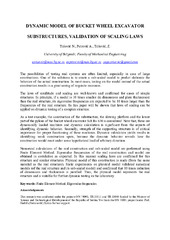Приказ основних података о документу
Dynamic model of bucket wheel excavator substructures, validation of scaling laws
| dc.creator | Trišović, Nataša | |
| dc.creator | Petrović, Ana | |
| dc.creator | Trišović, Zaga | |
| dc.date.accessioned | 2023-03-13T13:48:07Z | |
| dc.date.available | 2023-03-13T13:48:07Z | |
| dc.date.issued | 2019 | |
| dc.identifier.uri | https://machinery.mas.bg.ac.rs/handle/123456789/6003 | |
| dc.description.abstract | The possibilities of testing real systems are often limited, especially in case of large constructions. One of the solutions is to create a sub-scaled model to predict elaborate the behavior of the actual construction. In most cases, testing on the model instead of the actual construction results in a great saving of requisite resources. The laws of similitude and scaling are well-known and confirmed for cases of simple structures. In principle, if a model is 10 times smaller (in dimensions and plate thicknesses) than the real structure, its eigenvalue frequencies are expected to be 10 times larger than the frequencies of the real structure. In this paper will be shown that laws of scaling can be applied on dynamic testing of a complex structure. As a test example, the construction of the substructure, the slewing platform and the lower part of the pylons of the bucket wheel excavator Sch Rs 630 is considered. Note that, these are dynamically loaded machines and dynamic calculation is significant from the aspects of identifying dynamic behavior. Secondly, strength of the supporting structure is of critical importance for proper functioning of these machines. Dynamic calculation yields results in identifying weak construction spots, because the dynamic behavior reveals how the construction would react under some hypothetical load of arbitrary direction. Numerical calculations of the real construction and sub-scaled model are performed using Finite Element Method. Eigenvalue frequencies of the real construction and model are obtained in correlation as expected. In this manner scaling laws are confirmed for this structure and similar structures. Physical model of this construction is made (from the same material as the real structure). Static experiments on physical model validated numerical models (of the real structure and its sub-scaled model) and confirmed that 10 times reduction of dimensions and thicknesses is justified. Thus, the physical model represents the real structure and is suitable for further dynamic testing in the laboratory. | sr |
| dc.language.iso | en | sr |
| dc.relation | info:eu-repo/grantAgreement/MESTD/Technological Development (TD or TR)/35040/RS// | sr |
| dc.relation | info:eu-repo/grantAgreement/MESTD/Technological Development (TD or TR)/35011/RS// | sr |
| dc.rights | openAccess | sr |
| dc.rights.uri | https://creativecommons.org/licenses/by/4.0/ | |
| dc.source | International Conference on Nonlinear Solid Mechanics-ICoNSoM2019, Abstract Book, Roma, Italy | sr |
| dc.subject | Finite Element Method | sr |
| dc.subject | Eigenvalue frequencies | sr |
| dc.title | Dynamic model of bucket wheel excavator substructures, validation of scaling laws | sr |
| dc.type | conferenceObject | sr |
| dc.rights.license | BY | sr |
| dc.citation.rank | M34 | |
| dc.identifier.fulltext | http://machinery.mas.bg.ac.rs/bitstream/id/14875/bitstream_14875.pdf | |
| dc.identifier.rcub | https://hdl.handle.net/21.15107/rcub_machinery_6003 | |
| dc.type.version | publishedVersion | sr |


